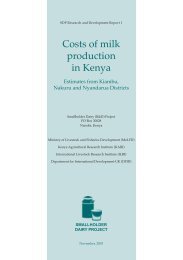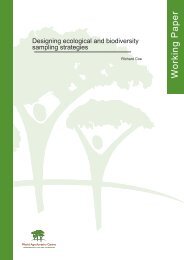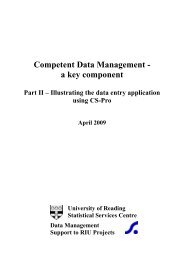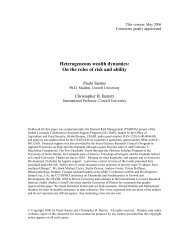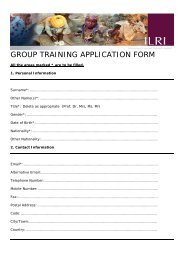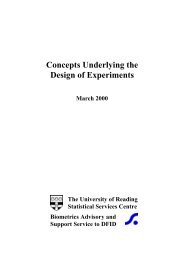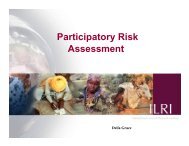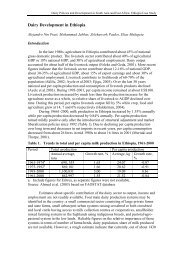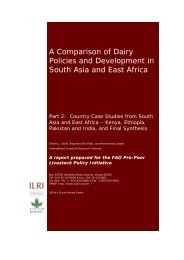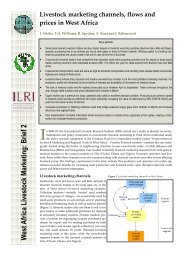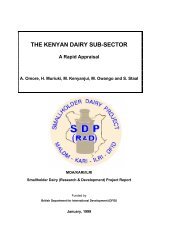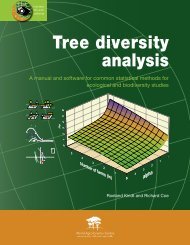undertaken between 1985 and 1994 <strong>in</strong> three phases. The first phase focused on the most appropriate farm<strong>in</strong>gsystems model, the second phase evaluated socio-economic factors, and the third phase was concerned withadoption <strong>of</strong> the model. The results over n<strong>in</strong>e years showed that <strong>in</strong>creased <strong>in</strong>comes and improved livelihoodswere associated with enhanced crop yields, animal production, the development <strong>of</strong> a revolv<strong>in</strong>g fund, andself-reliance. Table A2 presents the economic benefits derived from these improvements compared totraditional practices. The contribution <strong>of</strong> animals to total farm <strong>in</strong>come was 10% compared to 17.3% for rubberand 72.7% for food crops. The table <strong>in</strong>dicates that total expenditures were consistently higher amongstadopters, yet net <strong>in</strong>comes <strong>of</strong> adopters were consistently higher than those <strong>of</strong> non-adopters. Furthermore,expenditure patterns <strong>in</strong>dicated higher levels <strong>of</strong> spend<strong>in</strong>g by adopters on better-quality food items, and<strong>in</strong>vestment <strong>in</strong> the education <strong>of</strong> children.To ease population pressures on Java, there have been cont<strong>in</strong>u<strong>in</strong>g efforts by government to relocatefamilies to the sparsely populated areas <strong>of</strong> Sumatera, Kalimantan and Irian Jaya. S<strong>in</strong>ce the ma<strong>in</strong> economicactivity <strong>in</strong>tended for the settlers is rubber production, the role <strong>of</strong> animals <strong>in</strong> stabilis<strong>in</strong>g the <strong>in</strong>comes <strong>of</strong> theserelocated families is significant, especially dur<strong>in</strong>g the early years <strong>of</strong> resettlement. <strong>Animal</strong>s also providepotential for further <strong>in</strong>creases <strong>in</strong> <strong>in</strong>come <strong>in</strong> the future. However, there are some constra<strong>in</strong>ts to such <strong>in</strong>tegrationwhich are now discussed.Table A2. Net <strong>in</strong>come and expenditures <strong>of</strong> farmers us<strong>in</strong>g traditional and improved crop–animal systems on Sumatera(1992–1994).Batumarta Dua Tulang Bawang Tengah Air ManganyauParameter Project Traditional Project Traditional Project TraditionalNet farm161 118 138 81 124 24<strong>in</strong>comeExpendituresTotal 95 85 90 54 77 67Rice 21 25 18 14 18 23Meat/fish 25 24 20 14 27 25Hous<strong>in</strong>g 12 6 6 6 2 2Education 6 2 10 3 4 237 32 29 17 26 15Source: CRIFC (1995).Exchange rate: US$ 1= Rp 19.63Labour and genderExperiments show that 1 head <strong>of</strong> cattle, 3 goats and 11 native chicken (Batumarta Dua <strong>in</strong> Table 2) require125 person-days <strong>of</strong> labour, roughly 27% <strong>of</strong> the total labour requirement <strong>of</strong> a rubber-based farm. As villagesbecome more market-orientated, there is <strong>in</strong>creas<strong>in</strong>g competition for labour <strong>in</strong> car<strong>in</strong>g for animals and for otheractivities both on- and <strong>of</strong>f-farm. Farmers have found more productive uses for labour <strong>in</strong> other activities, andthe role <strong>of</strong> women <strong>in</strong> animals’ welfare has become even more critical. In Batumarta Dua, for example, theaverage labour days allocated for <strong>of</strong>f- and non-farm work <strong>in</strong>creased from 52 person-days <strong>in</strong> 1992/93 to 59person-days <strong>in</strong> 1994/95.Research on the <strong>in</strong>volvement <strong>of</strong> women <strong>in</strong> the management <strong>of</strong> small rum<strong>in</strong>ants revealed that 87% <strong>of</strong> thewomen <strong>in</strong> rubber plantations <strong>in</strong> Srogol Village, Bogor, and 76% <strong>of</strong> women <strong>in</strong> the coastal village <strong>of</strong> Wanaraja,Cirebon, helped to raise small rum<strong>in</strong>ants. Results also showed that women from the small farms were eitherdom<strong>in</strong>ated by men or, at best, were equal to their husbands. On the other hand, women from medium-sized farmshad complete freedom <strong>in</strong> decision-mak<strong>in</strong>g or at least had rights equal to those <strong>of</strong> their husbands. Based onprevious research <strong>in</strong> three areas <strong>of</strong> west Java (Bandung, Pandeglang and Majalengka), it was found that women<strong>in</strong> these areas contributed 22, 25 and 30%, respectively, to the total work<strong>in</strong>g hours needed for rais<strong>in</strong>g smallrum<strong>in</strong>ants. In the transmigration areas, women contribute as much as 33% <strong>of</strong> the total farm labour requirement.
Women work 11.5 h/day on average compared to 10 h for men. In terms <strong>of</strong> time allocation, women devote 25%<strong>of</strong> their time to agriculture, 23% to household tasks and the rest to the other activities. Men contribute 38% <strong>of</strong>their time to agriculture, 5% to household tasks and the rest to other activities. The implication for agriculturaldevelopment is the need to <strong>in</strong>clude women <strong>in</strong> tra<strong>in</strong><strong>in</strong>g and extension activities.Credit and sav<strong>in</strong>gsThere is difficulty <strong>in</strong> gett<strong>in</strong>g formal credit for animal agriculture. Many smallholders have <strong>in</strong>sufficientcollateral because land ownership on densely populated islands such as Java may be as low as 0.25 ha.Government credit programmes (e.g. revolv<strong>in</strong>g funds <strong>in</strong> the Batumarta Dua, Tulang Bawang Tengah andAir Manganyau Transmigration Projects) are unsusta<strong>in</strong>able, especially if there is no supervision. Thecoverage is limited, and the <strong>in</strong>terest rate for commercial credit is high (16%). Furthermore, the ruralsav<strong>in</strong>gs <strong>of</strong> smallholders are <strong>of</strong>ten not mobilised due to a lack <strong>of</strong> f<strong>in</strong>ancial <strong>in</strong>termediaries, and farmers areforced to use animals as their means <strong>of</strong> sav<strong>in</strong>gs. This requires a micro-economic policy response wherebythe deposit<strong>in</strong>g <strong>of</strong> sav<strong>in</strong>gs and the advancement <strong>of</strong> credit are comb<strong>in</strong>ed <strong>in</strong> one <strong>in</strong>stitution. This may also<strong>in</strong>crease the market-orientation <strong>of</strong> farmers and encourage them to sell more animals, rather than keep<strong>in</strong>gthem as sav<strong>in</strong>gs.Extension and rural <strong>in</strong>stitutionsImproved crop–animal technology, developed from farm<strong>in</strong>g systems research, is not dissem<strong>in</strong>ated widely.The l<strong>in</strong>kage between research and extension at the national policy-mak<strong>in</strong>g level is weak. The Directorate forAgricultural Research is <strong>in</strong>dependent <strong>of</strong> the Directorate for Extension, and the priorities for each, especially<strong>in</strong> implementation, are <strong>of</strong>ten <strong>in</strong>consistent. The development <strong>of</strong> rural <strong>in</strong>stitutions such as farmer co-operativesis slow. At best, established farmer-organisations deal<strong>in</strong>g with animals are operat<strong>in</strong>g only <strong>in</strong>formally. Thereis a need to strengthen, where necessary, established farmer-organisations with the aim <strong>of</strong> address<strong>in</strong>g thenumerous deficiencies faced by smallholders. Market<strong>in</strong>g, credit and other constra<strong>in</strong>ts are better addressedwith strong rural <strong>in</strong>stitutions such as peasant organisations.Tra<strong>in</strong><strong>in</strong>gMany smallholders <strong>in</strong> the transmigration areas are reluctant to raise animals because they lack the necessaryexperience <strong>in</strong> tak<strong>in</strong>g care <strong>of</strong> the animals. In Air Mangangyau, for example, very few farmers raise goatsbecause <strong>of</strong> their lack <strong>of</strong> experience <strong>in</strong> handl<strong>in</strong>g the animals.Lao PDREnvironment and cropp<strong>in</strong>g systemsThe Lao PDR is a land-locked nation that lies with<strong>in</strong> the watershed <strong>of</strong> the Mekong River. Some 80% <strong>of</strong> theland surface is made up <strong>of</strong> hills and mounta<strong>in</strong>s. There are three ma<strong>in</strong> AEZs (Bouahom 1995) consist<strong>in</strong>g <strong>of</strong>uplands, plateaux and lowlands. The uplands are mounta<strong>in</strong>ous regions from 1100–3000 m altitude, thatcomprise some 60% <strong>of</strong> the land area. The plateaux range from 800–1300 m, and the lowlands are pla<strong>in</strong>s lessthan 800 m above sea level. The government has given special priority to the prov<strong>in</strong>ce <strong>of</strong> Xieng Khouangfor the future development <strong>of</strong> rum<strong>in</strong>ant production. In this prov<strong>in</strong>ce three AEZs have been identified byGibson (1996) as the p<strong>in</strong>e-tree grassland savannah zone at 1100 m altitude, the fertile soils at high altitudeszone (1200–1500 m), and fertile soils at low altitudes zone (500–1000 m).The tropical monsoonal climate is characterised by alternat<strong>in</strong>g wet and dry seasons. In the uplands,ra<strong>in</strong>fall is 1500–2000 mm annually. On the plateaux, annual ra<strong>in</strong>fall varies from 2000–4000 mm, fall<strong>in</strong>gmostly from May to October. Average annual temperatures range from 20–31°C, with the lowest temperature(15°C) <strong>in</strong> December and the highest (35°C) <strong>in</strong> April. In the lowlands, ra<strong>in</strong>fall is 1300–1700 mm, with most<strong>of</strong> the ra<strong>in</strong> occurr<strong>in</strong>g from May to September. Average annual temperatures vary from 21–30°C. In thep<strong>in</strong>e-tree savannah zone <strong>of</strong> Xieng Khouang Prov<strong>in</strong>ce, annual average ra<strong>in</strong>fall is 1500 mm and average annualtemperature 20°C.
- Page 2 and 3:
Affiliation of Authors:Dr C. Devend
- Page 4 and 5:
6.Strategyfor researchJustification
- Page 7 and 8:
AcknowledgementsThe International L
- Page 9 and 10:
esearch opportunities appropriate t
- Page 11 and 12:
Table 1.Animal populations and meat
- Page 13 and 14:
Introduction2. Characterisation and
- Page 15 and 16:
Figure 2. Sub-humid tropics and sub
- Page 17 and 18:
Table 3.Human and animal population
- Page 19 and 20: Table 5. Rice-growing environments
- Page 21 and 22: Multiple upland annual crop systems
- Page 23 and 24: Table 6. Continued.Country Importan
- Page 25 and 26: It should be noted that, compared w
- Page 27 and 28: Table 8.CountryCambodiaChinaIndones
- Page 29 and 30: of non-renewable fossil fuels and t
- Page 31 and 32: Overview of researchThere was a sur
- Page 33 and 34: • Identification of alternative c
- Page 35 and 36: Various animal production systems t
- Page 37 and 38: Presently, much of the vegetable pr
- Page 39 and 40: Table 10. Summary of the main socio
- Page 41 and 42: Table 11. Institutions and organisa
- Page 43 and 44: 3. In the ASEAN sub-region, inadequ
- Page 45 and 46: Table 12. Continued.SituationsPract
- Page 47 and 48: 6. Strategy for researchJustificati
- Page 49 and 50: Table 13. Priorities for research a
- Page 51 and 52: VietnamResearch capacity in NARS is
- Page 53 and 54: CRIFC (Central Research Institute f
- Page 55 and 56: IAS. 1995. Proceedings of the Works
- Page 57 and 58: Systems of sub-Saharan Africa. Volu
- Page 59 and 60: or waterlogged in the wet season an
- Page 61 and 62: Table A1. Important diseases of ani
- Page 63 and 64: • Increased cropping intensities,
- Page 65 and 66: the animal output came from pigs al
- Page 67 and 68: 18-21° North, with an average rain
- Page 69: In the Nusa Tenggara islands, signi
- Page 73 and 74: Various Australian forage projects
- Page 75 and 76: village production systems; to stud
- Page 77 and 78: The availability of feed in rubber
- Page 79 and 80: of the Ayeyarwady and Sittang river
- Page 81 and 82: Constraints and opportunitiesInadeq
- Page 83 and 84: gaining in importance, and signific
- Page 85 and 86: Table A3. Characterisation of crop-
- Page 87 and 88: Table A4. Interventions in crop-ani
- Page 89 and 90: Table A4. Continued.Project TitleGo
- Page 91 and 92: otations are practised, and there a
- Page 93 and 94: such as abortion. Vaccination cover
- Page 95 and 96: large areas of forests (3.4 million
- Page 97 and 98: Table A6. Some animal diseases repo
- Page 99 and 100: Appendix IIItineraryThe Philippines
- Page 101 and 102: 26 November 1996 am Visit to small
- Page 103 and 104: Appendix IIIList of persons metPhil
- Page 105 and 106: Mr Chhiv Nan, Acting Director, Depa
- Page 107 and 108: Dr U Maung Ngint, Managing Director
- Page 109: List of acronymsAARDACIARADBAEZAIBP



